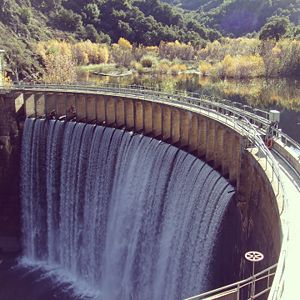San Clemente Dam
This page gives a short history of the San Clemente Dam and description of the planned dam removal project and its environmental impact and related issues and controversies.
Contents
History
The San Clemente Dam was built in 1921 by a local businessman Samuel Morse on the Carmel River to supply the water needs of Monterey's growing population and tourism industry. Later the dam was purchased by Chester Loveland who owned the California Water and Telephone Company (CW&T). To meet the needs of the growing population and increasing demand from the sardine processing industry in Monterey, CW&T built the [[Los Padres Dam]Los Padres Dam] upstream from San Clemente Dam in 1948 In 1966 CW&T sold the dam to California American Water for $42 million. [1] [2]
Geology and Ecology of Carmel River Watershed
Geology and Sedimentation
The Carmel River watershed is on a highly erodable geological formation (filler to be flushed out). Although the dam was built in 1921, by 1947 it was 25% silted [3] and is now 90% silted.
Seismic Considerations
Located near the Tularcitos fault, the San Clemente Dam is vulnerable a catastrophic failure due to an earthquake. With the dam having reached its expected useful life and with 1500 homes below the dam under threat, in 2006 the California Department of Water Resources decided that action had to be taken in order to mitigate the danger by either removing or reinforcing the dam.
Threatened Species
- Central Coast steelhead trout
- California red-legged frog
Current Topics
- 1990s - California Department of Water Resources (DWR) Division of the Safety of Dams(DSOD) issued a safety order which determined that in the event of the maximum credible earthquake or probable maximum flood the dam would potentially fail creating a public safetly issue [4].
- 2006 - DWR released a Draft Environmental Impact Report/Environmental Impact Statement (EIR/EIS). The EIR explored CalAm's preferred option of strengthening the Dam and four alternative projects, including the Carmel River Reroute and Dam Removal (CRRDR) option.
- 2008 - DSOD stated the Reroute and Removal project would address the dam's public safety issues and other environmental impacts caused by the dam making it the best option for all stakeholders [5].
Dam Removal
Benefits of reroute plan:
- Permanent resolution to the dam safety concern
- Access for endangered steelhead trout to 25+ miles of spawning and rearing habitat
- Restoration of sediment to the downstream reach of the river and Carmel River State Beach
- Restored ecological connectivity for riparian and aquatic habitats
Carmel River Reroute and Dam Removal Project description:
- Construction Access Roads- In order to carry out the CRRDR access roads are being constructed off of Carmel Valley Road after Carmel Valley Village and before the Sleepy Hollow turn-off.
- Diversion Dike
- Reroute Channel and Upper Carmel River Reach
- Combined Flow Reach and Upper San Clemente Creek Reach
- Stabilized Sediment Slope
- Sediment Stockpile
- Dam Removal
- Old Carmel River Dam (OCRD) Removal
Timeline
Construction is set to begin in 2013, and the estimated completion is set for 2015.
Environmental Impacts
References
- ↑ CalAm page http://www.amwater.com/caaw/customer-service/rates-information/monterey-san-clemente-dam-removal-project.html
- ↑ History - "Water Over the Dam" by Keith Vandevere http://www.kiracorser.com/ecoart/history/time.htm
- ↑ Carmel Vally Association "Carmel River History"
- ↑ San Clemente Dam Removal Project Summary
- ↑ San Clemente Dam Removal Project Summary
Links
Disclaimer
This page may contain students's work completed as part of assigned coursework. It may not be accurate. It does not necessarily reflect the opinion or policy of CSUMB, its staff, or students.

